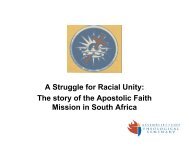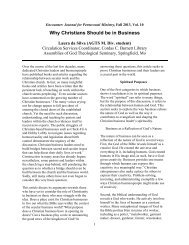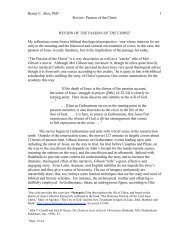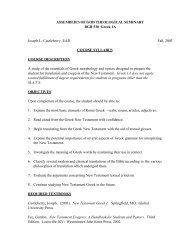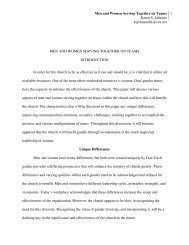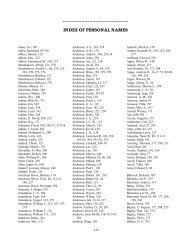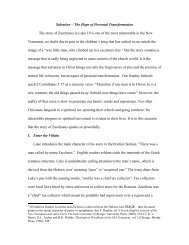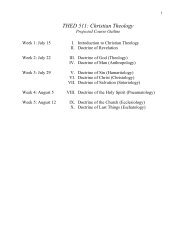Encounter: Journal for Pentecostal Ministry - Assemblies of God ...
Encounter: Journal for Pentecostal Ministry - Assemblies of God ...
Encounter: Journal for Pentecostal Ministry - Assemblies of God ...
You also want an ePaper? Increase the reach of your titles
YUMPU automatically turns print PDFs into web optimized ePapers that Google loves.
<strong>Encounter</strong>: <strong>Journal</strong> <strong>for</strong> <strong>Pentecostal</strong> <strong>Ministry</strong>, Summer 2009, Vol. 6<br />
ALTA M. WASHBURN: ICONOCLASTIC PENTECOSTAL<br />
“TRAILBLAZER” TO THE TRIBES 1<br />
Introduction<br />
Joseph J. Saggio, Ed.D.<br />
Northwest University, Kirkland, Washington<br />
Associate Dean <strong>for</strong> Graduate Studies, College <strong>of</strong> <strong>Ministry</strong><br />
Associate Pr<strong>of</strong>essor <strong>of</strong> Church and Culture & U.S. Missions<br />
<strong>Assemblies</strong> <strong>of</strong> <strong>God</strong> Theological Seminary<br />
Adjunct Pr<strong>of</strong>essor<br />
I have spent so much time reflecting over these past <strong>for</strong>ty-two years <strong>God</strong> has<br />
given us to minister the Gospel to Native Americans. We feel no regrets, [we] only<br />
wish we could have many more years to work in this great Harvest <strong>for</strong> the Lord.<br />
Clarence and I are consoled by the knowledge that our vision is perpetuated by<br />
those whom our lives have touched.<br />
-Alta M. Washburn, Trail to the Tribes, p. 100.<br />
Historically,organizational and paradigmatic<br />
shifts occur when radical, iconoclastic<br />
leadership emerges, <strong>for</strong>cing the status quo in<br />
new directions. Iconoclasts challenge us to<br />
destroy our preconceived notions and stop<br />
venerating the past. They urge us to examine<br />
our previously held views and reshape our<br />
vision <strong>for</strong> the future.<br />
Alta M. Washburn (1906-1990) was one<br />
such iconoclastic leader. 2 Largely<br />
instrumental in the paradigmatic shift away<br />
from a “missionary-driven” model to the<br />
more “indigenous-driven” model <strong>of</strong><br />
leadership within the U.S. <strong>Assemblies</strong> <strong>of</strong><br />
<strong>God</strong> (AG) missions work among American<br />
Indians, 3 Washburn was boldly innovative in<br />
that she established the first <strong>Pentecostal</strong><br />
Bible college <strong>for</strong> Native Americans with the<br />
stated objective <strong>of</strong>: “…train[ing] the Native<br />
1<br />
Indian worker in sound Bible Doctrines that<br />
they may in turn go out to reach their own<br />
tribes in the native language, thereby<br />
spreading the Gospel quickly to every<br />
kindred, tribe and tongue.” 4<br />
In her role as a missionary church planter<br />
and founder <strong>of</strong> a Bible institute, Washburn<br />
was boldly innovative in her willingness to<br />
serve in a “male-dominated” role and also to<br />
promote the empowerment and equality <strong>of</strong><br />
Native Christian leadership at a time when<br />
such a position was considered untenable by<br />
many.<br />
This article briefly examines the life and<br />
ministry <strong>of</strong> this iconoclastic leader whose<br />
two most enduring contributions to AG<br />
missionary work among Native Americans<br />
include her missionary church planting <strong>of</strong><br />
several congregations in the southwestern<br />
United States, and the founding <strong>of</strong> the first



